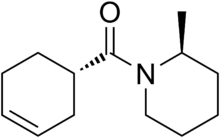SS220
SS220 is an insect repellent with a broad range of efficacy.
 | |
| Names | |
|---|---|
| Other names
(1S,2'S)-Methylpiperidinyl-3-cyclohexen- 1-carboxamide (2S)-1-[(1S)-Cyclohex-3-en-1-ylcarbonyl]-2-methylpiperidine | |
| Identifiers | |
| ChemSpider | |
| Properties | |
| C13H21NO | |
| Molar mass | 207.317 g·mol−1 |
Except where otherwise noted, data are given for materials in their standard state (at 25 °C [77 °F], 100 kPa). | |
| Infobox references | |
It was developed in 2002 at the Chemicals Affecting Insect Behavior Laboratory of the United States Department of Agriculture[1] and has been found to "exert repellent and deterrent effects upon the behavior of mosquitoes and sand flies".[2] In the field, it has been shown to provide significantly better protection than DEET.[3] SS220 has a slightly fruity odor, tends not to provoke allergic skin reactions, lasts longer on the skin than other repellents, does not have an oily consistency, and does not tend to plasticize. Its principal disadvantage is that only one stereoisomer of the molecule is active, meaning it will be much more costly to produce than icaridin. As of 2007 the chemical had not been registered, and the costs involved in registration are prohibitively enormous.[4]
See also
References
- Klun, J. A.; Khrimian, A.; Margaryan, A.; Kramer, M.; Debboun, M. (2003). "Synthesis and Repellent Efficacy of a New Chiral Piperidine Analog: Comparison with Deet and Bayrepel Activity in Human-Volunteer Laboratory Assays Against Aedes aegypti and Anopheles stephensi". Journal of Medical Entomology. 40 (3): 293–299. doi:10.1603/0022-2585-40.3.293. PMID 12943107.
- Klun, Jerome A.; Khrimian, Ashot; Debbound, Mustapha (2006). "Repellent and Deterrent Effects of SS220, Picaridin, and Deet Suppress Human Blood Feeding by Aedes aegypti, Anopheles stephensi, and Phlebotomus papatasi". Journal of Medical Entomology. 43 (1): 34–39. doi:10.1093/jmedent/43.1.34.
- Frances, Stephen P.; Mackenzie, Donna O.; Klun, Jerome A.; Debboun, Mustapha (2009). "Laboratory and Field Evaluation of SS220 and Deet Against Mosquitoes in Queensland, Australia". Journal of the American Mosquito Control Association. 25 (2): 174–178. doi:10.2987/08-5823.1. PMID 19653499.
- Mustapha Debboun; Stephen P. Frances; Daniel Strickman (25 October 2006). Insect Repellents: Principles, Methods, and Uses. CRC. pp. 10–11. ISBN 978-1-4200-0665-0.